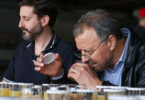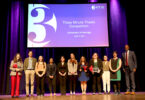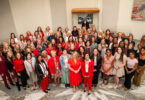Athens, Ga. – An article by two University of Georgia researchers in the latest issue of the Journal of Poverty demonstrates that students participating in a simulation “soften their attitudes” regarding those who live in poverty.
Sharon Y. Nickols, the Janette McGarity Barber Distinguished Professor in the College of Family and Consumer Sciences, and Robb Nielsen, an assistant professor in the college, conducted both a qualitative and quantitative study to determine whether students developed “social empathy” after participating in a two-and-a-half hour simulation titled, “Welcome to the State of Poverty.”
During the simulation, students in Nickols’ course on managing family resources are clustered into various family groups-two parents and two children; an older woman living alone; a single mother with two children; and a cohabiting couple, for example. Faculty members and other volunteers play the roles of community members, such as the town banker, pawn shop owner and a social services employee. During the course of the simulation, the participants must accomplish a variety of tasks, including buying groceries, paying their bills and caring for both toddlers and aging parents while subsisting on low wages and other issues, such as being unable to speak English. During the course of each 15-minute “month,” new situations are randomly interjected. In some cases, these are helpful events, such as an unemployed parent receiving a job. In other cases, the events add to the families’ difficulties, such as a family without health insurance facing illness.
The simulation, which is led by Cooperative Extension Multicultural Specialist Sharon Gibson, has been used for many years with a variety of community leaders to help them realize the complexities of poverty, but the study by Nickols and Nielsen is apparently the first to measure its impact on college students.
In conducting their study, Nickols and Nielson used two ways of measuring students’ attitudes-a pre- and post-test and a reflective paper that was written after the simulation. What they found, according to Nielsen, was that the students were better able to identify with the experiences and reactions of those in adverse or difficult situations.
“It wasn’t a dramatic change, but we didn’t expect a dramatic change,” he said. “These students started relatively empathetic and became more empathetic.”
Among the changes, participants in the simulation shifted their opinions about whether people who are poor attempt to get out of poverty; whether they attempt to save money; and whether they’d rather work than be on welfare. In addition, their views on whether the poor have equal access to health care and whether the government does enough to help those who are poor, also shifted. They gained a better understanding of the fact that there are more children than adults living in poverty.
In looking at the reflective papers the students wrote a week after the simulation, the researchers found that 65 of the 75 students who wrote papers described themselves as having gained greater insights into the lives of the poor as a result of the simulation. Among the remaining students, seven reported no change in their opinions (in some cases, they stated they already were empathetic to the poor) and the responses of three students were ambiguous.
“I began to understand and realize that it’s not always a person’s fault for being in a poverty-stricken lifestyle,” wrote one student. “Just sitting in an environment of failure makes your own drive to succeed that much harder.”
Another student was surprised by the difficulty of assessing social services: “I knew very little about TANF (Temporary Assistance for Needy Families). I cannot imagine that everyone that is in need of help knows all about the programs available to them.”
One finding the authors hadn’t anticipated, based on previous studies that examined empathy, was the stress the participants felt as they inhabited the roles of those living in poverty.
“The stress…was brought on entirely by my family’s financial insecurity,” a student said. “I had little time to do anything other than go to work, run errands and pay the bills; I barely saw my children or husband and never had the chance to relax.”
“Getting groceries, applying for TANF and food stamps and going to the QuickCash all took so long to get accomplished,” wrote another. “I think that many people in poverty would feel like they were on a treadmill, not really getting anywhere.”
“Much of what students learn in the family resources class emphasizes the breadth of resources that are available, including time, space, and family and community support, in addition to the monetary and material goods we frequently think of,” Nickols said. “Part of what this simulation demonstrates is what happens when you’re missing a number of those resources.”







